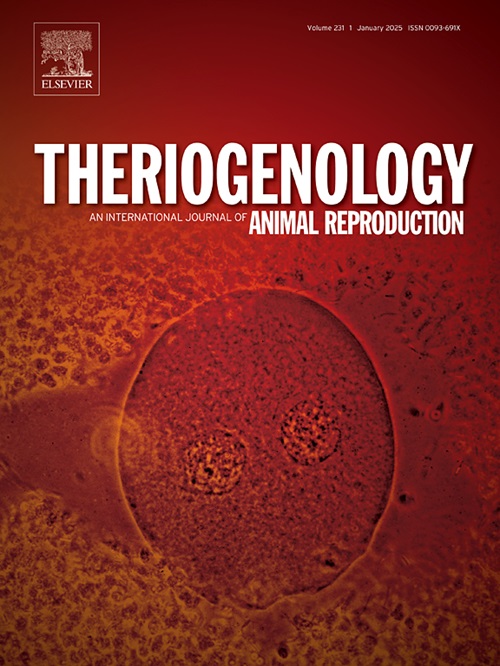体内卵巢温度对牛早期窦卵泡卵母细胞的体外生长和发育能力有促进作用
IF 2.4
2区 农林科学
Q3 REPRODUCTIVE BIOLOGY
引用次数: 0
摘要
在牛中,用于未成熟卵母细胞体外生长(IVG)的培养温度一般为38.5℃或39.0℃,接近阴道或直肠内的正常温度。然而,体内卵巢组织的温度比阴道或直肠低约1°C(37.5°C)。因此,普遍接受的培养温度可能不是牛卵母细胞体外培养的最佳温度。在此,我们研究了培养温度对早期窦卵泡(直径0.5-1 mm)卵母细胞-卵丘颗粒复合物(ocgc) IVG的影响。ocgc在37.5、38.5和39.0℃的温度下进行12天的IVG。每4 d评估OCGC活力和窦腔形成。用酶免疫法测定第1、2、3天ocgc的雌二醇-17β (E2)和孕酮(P4)的产生。IVG后存活的ocgc进行体外成熟(IVM)、体外受精和胚胎培养。然后观察体外受精后卵母细胞的核状态和直径、卵裂率和囊胚率以及囊胚细胞数。此外,测定IVG后颗粒细胞中热休克蛋白(HSPs) mRNA表达和卵母细胞中还原性谷胱甘肽(GSH)水平。各组间OCGCs的存活率无显著差异,而IVG培养第12天的胃窦形成率以37.5°C组最高(P <;0.05)。各组间P4产量无差异;然而,在8-12天,37.5°C组E2的产量往往高于其他两组的总和(P <;0.1)。各组大鼠卵母细胞HSP70、90 mRNA表达及GSH水平无显著差异。37.5℃组培养后卵母细胞直径大于39.0℃组(P <;0.05), 38.5°C组介于其他两组之间。核成熟率和卵裂率在各组之间没有差异。37.5℃和38.5℃组的囊胚率高于39.0℃组(P <;0.05)。38.5℃组囊胚细胞数量小于体外培养的卵母细胞,37.5℃组囊胚细胞数量与体外培养的卵母细胞数量无显著差异。综上所述,37.5℃组ocgc形态和甾体生成健康,卵母细胞生长发育能力较好。因此,接近体内卵巢组织温度的培养条件是成熟牛卵母细胞体外培养的最佳条件。本文章由计算机程序翻译,如有差异,请以英文原文为准。
In vivo ovarian temperature promotes the in vitro growth and developmental competence of oocytes derived from bovine early antral follicles
In cattle, the culture temperature used for the in vitro growth (IVG) of immature oocytes is generally 38.5 or 39.0 °C, which is close to the normal temperature in the vagina or rectum. However, the temperature in the in vivo ovarian tissue is approximately 1 °C lower (37.5 °C) than that in the vagina or rectum. Therefore, the generally accepted culture temperature may not be optimal for the IVG of bovine oocytes. Herein, we investigated the effects of culture temperature on the IVG of oocyte-cumulus granulosa complexes (OCGCs) derived from early antral follicles (0.5–1 mm in diameter). OCGCs were subjected to 12 days of IVG at temperatures of 37.5, 38.5, and 39.0 °C. OCGC viability and antrum formation were evaluated every 4 days. Estradiol-17β (E2) and progesterone (P4) production from OCGCs during the 1st, 2nd, and 3rd 4-day periods was evaluated by enzyme immunoassay. Viable OCGCs after IVG were subjected to in vitro maturation (IVM), in vitro fertilization, and embryo culture. Then, the nuclear status and diameter of oocytes after IVM, rates of cleavage and blastocysts, and cell number in blastocysts were evaluated. In addition, the mRNA expression of heat shock proteins (HSPs) in the granulosa cells and reduced glutathione (GSH) levels in oocytes after IVG were measured. The viability of OCGCs did not differ among the groups, whereas the rate of antrum formation on day 12 of IVG culture was highest in the 37.5 °C group (P < 0.05). P4 production did not differ among the groups; however, E2 production during days 8–12 tended to be higher in the 37.5 °C group than in the other two groups combined (P < 0.1). The mRNA expression of HSP70 and 90, and the GSH levels of oocytes, did not differ among the groups. The oocyte diameter after culture was larger in the 37.5 °C group than in the 39.0 °C group (P < 0.05), and that in the 38.5 °C group was intermediate between the other two groups. The rates of nuclear maturation and cleavage did not differ among the groups. However, the blastocyst rate was higher in the 37.5 and 38.5 °C groups than in the 39.0 °C group (P < 0.05). The cell number in the blastocysts in the 38.5 °C group was smaller than the in vivo-grown oocytes, while that in the 37.5 °C group and the in vivo-grown oocytes did not differ. In summary, OCGCs in the 37.5 °C group showed healthy morphology and steroidogenesis, as well as better growth and developmental competence of oocytes. Therefore, culture conditions close to the in vivo ovarian tissue temperature would be optimal for the IVG of immature bovine oocytes.
求助全文
通过发布文献求助,成功后即可免费获取论文全文。
去求助
来源期刊

Theriogenology
农林科学-生殖生物学
CiteScore
5.50
自引率
14.30%
发文量
387
审稿时长
72 days
期刊介绍:
Theriogenology provides an international forum for researchers, clinicians, and industry professionals in animal reproductive biology. This acclaimed journal publishes articles on a wide range of topics in reproductive and developmental biology, of domestic mammal, avian, and aquatic species as well as wild species which are the object of veterinary care in research or conservation programs.
 求助内容:
求助内容: 应助结果提醒方式:
应助结果提醒方式:


